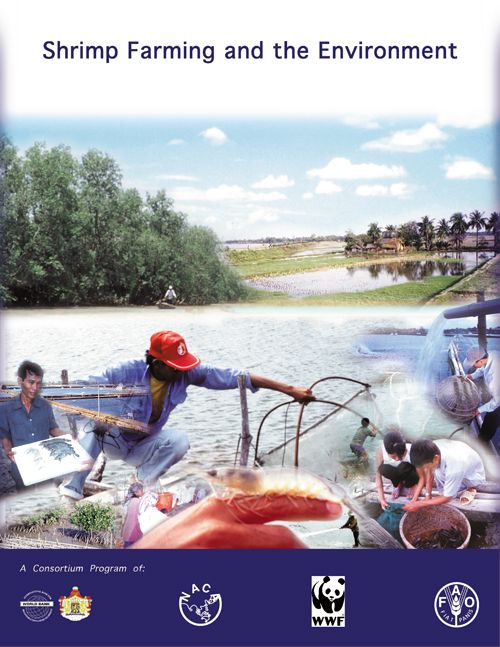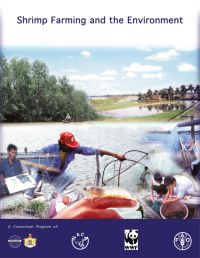Case studies of Ecuadorian shrimp farming (abstract)
23 November 2003 | Stanislaus Sonnenholzner, Laurence Massaut, Carlos Saldias, Jorge Calderon and Claude E. Boyd | 3007 Downloads | .pdf | 18.6 KB | Better management practices, Health and Biosecurity, Livelihoods, gender and social issues, Aquatic plants, Shrimp, Environment and Sustainability
Shrimp farming in Ecuador is characterised by extensive and semi-intensive production systems. Stocking densities range between 8 to 14 post larvae (PL)/m2 and shrimp yields after 90-120 days of grow-out average 1,200 kg/ha per year. During the 1970s and 1980s, the industry relied almost entirely on wild PL. Unpredictability in wild PL supply and disease outbreaks has forced the industry to use more hatchery PL in the past few years. Records of the larvae source for 14 commercial shrimp farms during the period 1995-2000 indicate a decrease in the number of ponds stocked with wild PL from 58% in 1995 to 7% in 2000. The driving force for wild PL preference over hatchery PL in the past, besides lower prices because of a greater supply during warm months and El Niño years, is the belief among farm managers that wild larvae outperform hatchery larvae during grow-out in ponds. Analysis of production data from commercial farms showed no difference in growth rates or yields between ponds stocked with wild and hatchery larvae. Currently there are 308 registered shrimp hatcheries with a production capacity of 58 billion PL per year. This is enough to supply estimated yearly demand of 45 billion larvae.
Less reliance on wild PL has several advantages to the shrimp industry. It will allow greater control over the supply and price of PL. This will allow farms to be stocked in a timely manner and more reliable estimates of costs can be made. Moreover, in the hatchery, it is possible to produce disease-free PL and to verify this fact so that farmers can feel more confident that they are not introducing white spot syndrome virus or other diseases into ponds at stocking. Hatcheries also can implement programs for breeding lines of shrimp that perform better in grow-out ponds. There also are environment benefits such as protection of the natural shrimp fisheries and biodiversity through use of hatchery PL. Of course, the use of farm-reared broodstock should also be encouraged to maximise environmental benefits of greater use of hatchery PL. Shrimp farming in Ecuador started in tidal flats that included mangrove areas. Tidal flow for filling ponds was considered one of the most important criteria for site selection. This criterion has changed over the years, as more knowledge on soil and water quality parameters for sustainable aquaculture has been acquired. However, many ponds constructed on mangrove soils are still in production today. Soils of ponds constructed on former mangrove areas are more acidic and contain more carbon and sulfur than those of pond built in mangrove areas. However, production data of farms having ponds on different soil types including former mangrove areas revealed no difference in growth, survival and yields among mangrove and non-mangrove soil during the last five years. Nevertheless, mangrove areas are low, and poorly drained. Soils often contain large amounts of carbon and sulfide sulfur and have a very wide carbon: nitrogen (C:N) ratio. The presence of a C:N ratio of 20 or above in pond bottom soils is highly suggestive in Ecuador and possibly In other places that ponds were constructed on former mangrove land. Thus, from the stand points of construction, soil management, and disease control, mangrove areas are not as suitable as many other areas for shrimp farming.
A study of the quality of intake water at the pumping station, pond inflow, and pond outflow was made on shrimp farms in Ecuador. Ponds were selected to represent farms operating at low stocking density and using water from the sea, and farms operating at low, medium, and high stocking densities and using water from estuaries. Water quality variables measured in this study were total phosphorus, total suspended solids, 5-day biochemical oxygen demand (BOD5), and chlorophyll a. Farms used the same body of water as water supply and effluent recipient. Thus, farm intake water quality was thought to represent water quality conditions of the water body into which farms discharged. The quality of pond outflow was assumed to be similar in quality to farm effluent. This assumption is sometimes incorrect. Total suspended solids may increase as a result of erosion within the discharge canals before the final outfall.
Sometimes, intake water for the farms already had high concentrations of measured variables before it entered ponds. This was especially true for farms in estuaries. When the intake water is already polluted, compliance with effluent water quality standards such as those suggested by the Global Aquaculture Alliance (GAA) will be problematic. We suggest that the effluent limits recommended by GAA be applied to the difference in concentration between farm intake water and final farm outfall water. This would be much fairer to shrimp farmers than imposing limits on the concentrations of variables measured directly in effluent. In this study, intake water sometimes exceeded one or more of the GAA standards. Limits based on differences in concentration between farm intake and final outfall will still provide environmental protection, for farm discharge would not be of lower quality than the water body into which it discharges. Ponds were quite effective in removing phosphorus from water and reducing phosphorus loads in effluent. However, excessive fertilisation of ponds can cause high concentrations of phosphorus in effluents. Design and construction practices for reducing the pollution potential for effluents include sedimentation areas for both intake and discharge waters, erosion control in supply and discharge canals, and use of seawater when possible. Pond management practices for improving effluent quality include less water exchange, better fertilisation procedures, good feed management, and installation of methods to prevent erosion of pond bottoms and sides by mechanical aerators.
Relatively high pond water exchange rates have been considered the most viable and economic management tool to correct problems with low dissolved oxygen concentration and other water quality problems in large (10 to 20 hectare) ponds in Ecuador. The availability of a continuous and usually unlimited source of water from natural waterways in estuaries or the open sea, the absence of clear regulations on water use and effluent discharge, and cheap diesel fuel allowed this practice. However, the recent increase in diesel fuel cost because of removal of the government subsidy, and the occurrence of the white spot syndrome virus (WSSV) disease has caused farmers to reduce water exchange rates. By reducing water exchange, it is thought that there will be less chance of introducing the carriers of WSSV into ponds.
A survey (interviews) of 14 shrimp farmers revealed a decrease in exchange rates in last 2 years from 10- 15% pond volume/day to 1-3% or no water exchange at all. Eighty two percent of farmers agreed to have diminished their water exchange rates in past years. Reduction of disease risks in face of WSV epidemic, improvement of water quality and reduction of pumping costs were given as primary reasons for current water exchange practices.
In Ecuador, the law regarding mangroves is extremely confusing and amended fast. It results that mangroves are under the jurisdiction of a lot of different governmental agencies and Ministries. Along the years new entities have been created to coordinate efforts to protect mangrove and define annual management plan, but such agencies are either not operating, or with little resources or authority to have a real impact. A lack of effective regulation of the mangrove resources has probably contributed to its continuing destruction. Although laws were passed, a combination of exemptions for small-scale exploitation and lack of enforcement led to the wrong impression that mangrove forests were essentially free resources. Fortunately, there is increasing recognition of the problem and positive efforts are being taken to mitigate negative impacts. It is interesting to note that over the last five years, mangroves in Ecuador did not change in coverage and stabilised around 150,000 ha. However, field efforts are mainly coming from the private sector, such as the existing collaboration between Fundación Natura and the Camara Nacional de Acuacultura (CNA) and their joint program for mangrove vigilance and diffusion of basic regulations. In addition, a growing number of aquaculturists realise that better management practices need to be adopted. Some of these practices have led to protection of mangrove areas around shrimp farms, small-scale reforestation efforts in degraded areas and changes in hydrological conditions that led to the re-growth of surrounding mangrove areas. Those individual efforts, although of relatively small amplitude, are an indication that shrimp farmers respect certain aspects of the law governing mangrove cutting and have a growing interest in protecting the associated natural environment. It is then not surprising to see that CNA in association with GAA is developing environmental guidelines for the shrimp industry of Ecuador. The purpose is to promote greater environmental awareness within the industry and to protect mangrove forests from adverse impacts of coastal aquaculture. Such effort should be encouraged and their development promoted, not just among aquaculturists and conservationists, but also within the larger community.
Copyright, all rights reserved.

